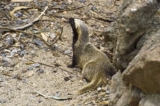
Galictis
Encyclopedia
The grison, also known as the South American glutton
, is a neotropical mustelid of South America
. Comprising the genus
Galictis, it is divided into two species: the greater grison
(Galictis vittata), which is found widely in South America
, through Central America
to southern Mexico
; and the lesser grison
(Galictis cuja), which is restricted to the southern half of South America. In Spanish
it is referred to as a huroncito (literally "little ferret") or grisón and in Portuguese
as a furão.
Grisons measure up to half a meter in length, and weigh between 1 and 3 kilograms. The lesser grison is slightly smaller than the greater. The grisons generally resemble a mink
, but with a shorter tail, shorter legs, and more robust body. The pelage along the back is a frosted gray with black legs, throat, face, and belly. A sharp white stripe extends from the forehead to the back of the neck.
They are found in a wide range of habitats from semi-open shrub and woodland to low-elevation forests. They burrow and nest in holes in fallen trees or rock crevices. They are omnivorous.
Wolverine
The wolverine, pronounced , Gulo gulo , also referred to as glutton, carcajou, skunk bear, or quickhatch, is the largest land-dwelling species of the family Mustelidae . It is a stocky and muscular carnivore, more closely resembling a small bear than other mustelids...
, is a neotropical mustelid of South America
South America
South America is a continent situated in the Western Hemisphere, mostly in the Southern Hemisphere, with a relatively small portion in the Northern Hemisphere. The continent is also considered a subcontinent of the Americas. It is bordered on the west by the Pacific Ocean and on the north and east...
. Comprising the genus
Genus
In biology, a genus is a low-level taxonomic rank used in the biological classification of living and fossil organisms, which is an example of definition by genus and differentia...
Galictis, it is divided into two species: the greater grison
Greater Grison
The greater grison, Galictis vittata, is an animal belonging to the ferret family Mustelidae from Central and South America, from southern Mexico to Brazil and Bolivia, living in savannas and rainforests, usually seen near rivers and streams....
(Galictis vittata), which is found widely in South America
South America
South America is a continent situated in the Western Hemisphere, mostly in the Southern Hemisphere, with a relatively small portion in the Northern Hemisphere. The continent is also considered a subcontinent of the Americas. It is bordered on the west by the Pacific Ocean and on the north and east...
, through Central America
Central America
Central America is the central geographic region of the Americas. It is the southernmost, isthmian portion of the North American continent, which connects with South America on the southeast. When considered part of the unified continental model, it is considered a subcontinent...
to southern Mexico
Mexico
The United Mexican States , commonly known as Mexico , is a federal constitutional republic in North America. It is bordered on the north by the United States; on the south and west by the Pacific Ocean; on the southeast by Guatemala, Belize, and the Caribbean Sea; and on the east by the Gulf of...
; and the lesser grison
Lesser Grison
The lesser grison , Galictis cuja, is a mammal species of the ferret family Mustelidae from South America. It is found in Argentina, Bolivia, Brazil, Chile, Paraguay, Peru, and Uruguay....
(Galictis cuja), which is restricted to the southern half of South America. In Spanish
Spanish language
Spanish , also known as Castilian , is a Romance language in the Ibero-Romance group that evolved from several languages and dialects in central-northern Iberia around the 9th century and gradually spread with the expansion of the Kingdom of Castile into central and southern Iberia during the...
it is referred to as a huroncito (literally "little ferret") or grisón and in Portuguese
Portuguese language
Portuguese is a Romance language that arose in the medieval Kingdom of Galicia, nowadays Galicia and Northern Portugal. The southern part of the Kingdom of Galicia became independent as the County of Portugal in 1095...
as a furão.
Grisons measure up to half a meter in length, and weigh between 1 and 3 kilograms. The lesser grison is slightly smaller than the greater. The grisons generally resemble a mink
Mink
There are two living species referred to as "mink": the European Mink and the American Mink. The extinct Sea Mink is related to the American Mink, but was much larger. All three species are dark-colored, semi-aquatic, carnivorous mammals of the family Mustelidae, which also includes the weasels and...
, but with a shorter tail, shorter legs, and more robust body. The pelage along the back is a frosted gray with black legs, throat, face, and belly. A sharp white stripe extends from the forehead to the back of the neck.
They are found in a wide range of habitats from semi-open shrub and woodland to low-elevation forests. They burrow and nest in holes in fallen trees or rock crevices. They are omnivorous.

